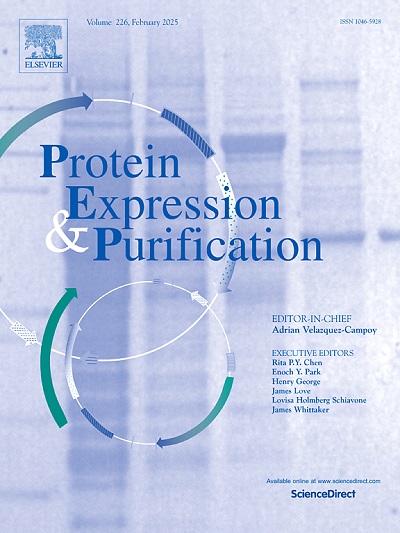High-throughput optimization of peptide-linker for fusing function protein with GFP
IF 1.2
4区 生物学
Q4 BIOCHEMICAL RESEARCH METHODS
引用次数: 0
Abstract
Fusion proteins are pivotal in bioengineering, with applications in purification, delivery, and imaging. However, the development of specialized peptide linkers tailored for target fusion proteins remains an unmet challenge. In this study, we demonstrate the optimization of fusing a functional protein with green fluorescent protein (GFP) through the screening of peptide linker sequences. Using seamless cloning methodology, a nanobody protein was fused to the N-terminus of GFP via a randomized 18-amino acid peptide linker library. Initial screening of fusion protein clones was conducted on solid plates to identify those expressing robust GFP fluorescence. A total of 153 clones with unique linker sequences were identified using Sanger sequencing. A wide range of normalized fluorescence signals was observed, revealing significant variability in linker performance. Among the screened linkers, one exhibited high fluorescence activity, outperforming commonly used flexible and rigid linkers. This finding underscores the necessity of optimize linker sequences for specific fusion proteins. Furthermore, the results demonstrated that the screened linker is compatible with diverse N-terminal proteins while maintaining GFP functionality. Additionally, to investigate the effect of linker on the function of target protein, we determined the reverse transcription efficiency of the murine leukemia virus reverse transcriptase (MLV-RT) in the fusion proteins by a two-step RT-qPCR method. In conclusion, this study presents an efficient optimization of peptide linkers, offering a novel methodology for the engineering and application of specialized linkers for fusion proteins.
功能蛋白与绿色荧光蛋白融合肽连接体的高通量优化
融合蛋白在生物工程中至关重要,在纯化、传递和成像方面都有应用。然而,针对目标融合蛋白的特殊肽连接物的开发仍然是一个未满足的挑战。在这项研究中,我们通过筛选肽连接序列,展示了功能蛋白与绿色荧光蛋白(GFP)融合的优化。采用无缝克隆方法,通过随机的18个氨基酸肽连接库将纳米体蛋白融合到GFP的n端。在固体板上进行融合蛋白克隆的初步筛选,以确定表达强大的GFP荧光的克隆。Sanger测序共鉴定出153个具有独特连接序列的克隆。观察到广泛的归一化荧光信号,揭示了连接剂性能的显着可变性。在所筛选的连接体中,有一种具有较高的荧光活性,优于常用的柔性和刚性连接体。这一发现强调了优化特定融合蛋白的连接子序列的必要性。此外,结果表明,筛选的连接子与多种n端蛋白兼容,同时保持GFP功能。此外,为了研究连接子对靶蛋白功能的影响,我们采用两步RT-qPCR方法测定了融合蛋白中小鼠白血病病毒逆转录酶(MLV-RT)的逆转录效率。总之,本研究提出了一种高效的肽连接物优化方法,为融合蛋白专用连接物的工程和应用提供了一种新的方法。
本文章由计算机程序翻译,如有差异,请以英文原文为准。
求助全文
约1分钟内获得全文
求助全文
来源期刊

Protein expression and purification
生物-生化研究方法
CiteScore
3.70
自引率
6.20%
发文量
120
审稿时长
32 days
期刊介绍:
Protein Expression and Purification is an international journal providing a forum for the dissemination of new information on protein expression, extraction, purification, characterization, and/or applications using conventional biochemical and/or modern molecular biological approaches and methods, which are of broad interest to the field. The journal does not typically publish repetitive examples of protein expression and purification involving standard, well-established, methods. However, exceptions might include studies on important and/or difficult to express and/or purify proteins and/or studies that include extensive protein characterization, which provide new, previously unpublished information.
 求助内容:
求助内容: 应助结果提醒方式:
应助结果提醒方式:


